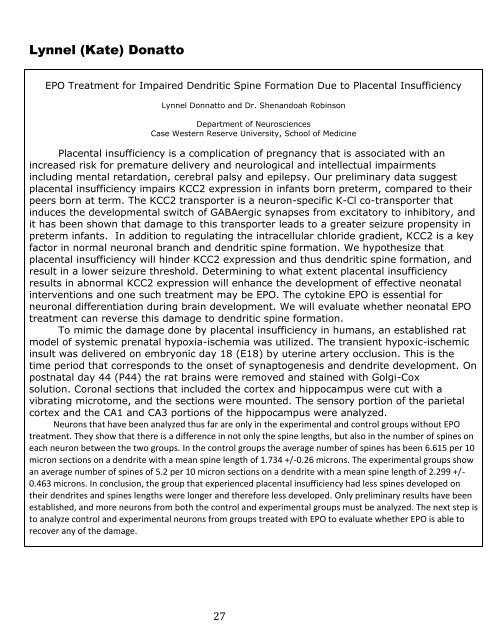student research day - Case Western Reserve University School of ...
student research day - Case Western Reserve University School of ...
student research day - Case Western Reserve University School of ...
You also want an ePaper? Increase the reach of your titles
YUMPU automatically turns print PDFs into web optimized ePapers that Google loves.
Lynnel (Kate) Donatto<br />
EPO Treatment for Impaired Dendritic Spine Formation Due to Placental Insufficiency<br />
Lynnel Donnatto and Dr. Shenandoah Robinson<br />
Department <strong>of</strong> Neurosciences<br />
<strong>Case</strong> <strong>Western</strong> <strong>Reserve</strong> <strong>University</strong>, <strong>School</strong> <strong>of</strong> Medicine<br />
Placental insufficiency is a complication <strong>of</strong> pregnancy that is associated with an<br />
increased risk for premature delivery and neurological and intellectual impairments<br />
including mental retardation, cerebral palsy and epilepsy. Our preliminary data suggest<br />
placental insufficiency impairs KCC2 expression in infants born preterm, compared to their<br />
peers born at term. The KCC2 transporter is a neuron-specific K-Cl co-transporter that<br />
induces the developmental switch <strong>of</strong> GABAergic synapses from excitatory to inhibitory, and<br />
it has been shown that damage to this transporter leads to a greater seizure propensity in<br />
preterm infants. In addition to regulating the intracellular chloride gradient, KCC2 is a key<br />
factor in normal neuronal branch and dendritic spine formation. We hypothesize that<br />
placental insufficiency will hinder KCC2 expression and thus dendritic spine formation, and<br />
result in a lower seizure threshold. Determining to what extent placental insufficiency<br />
results in abnormal KCC2 expression will enhance the development <strong>of</strong> effective neonatal<br />
interventions and one such treatment may be EPO. The cytokine EPO is essential for<br />
neuronal differentiation during brain development. We will evaluate whether neonatal EPO<br />
treatment can reverse this damage to dendritic spine formation.<br />
To mimic the damage done by placental insufficiency in humans, an established rat<br />
model <strong>of</strong> systemic prenatal hypoxia-ischemia was utilized. The transient hypoxic-ischemic<br />
insult was delivered on embryonic <strong>day</strong> 18 (E18) by uterine artery occlusion. This is the<br />
time period that corresponds to the onset <strong>of</strong> synaptogenesis and dendrite development. On<br />
postnatal <strong>day</strong> 44 (P44) the rat brains were removed and stained with Golgi-Cox<br />
solution. Coronal sections that included the cortex and hippocampus were cut with a<br />
vibrating microtome, and the sections were mounted. The sensory portion <strong>of</strong> the parietal<br />
cortex and the CA1 and CA3 portions <strong>of</strong> the hippocampus were analyzed.<br />
Neurons that have been analyzed thus far are only in the experimental and control groups without EPO<br />
treatment. They show that there is a difference in not only the spine lengths, but also in the number <strong>of</strong> spines on<br />
each neuron between the two groups. In the control groups the average number <strong>of</strong> spines has been 6.615 per 10<br />
micron sections on a dendrite with a mean spine length <strong>of</strong> 1.734 +/-0.26 microns. The experimental groups show<br />
an average number <strong>of</strong> spines <strong>of</strong> 5.2 per 10 micron sections on a dendrite with a mean spine length <strong>of</strong> 2.299 +/-<br />
0.463 microns. In conclusion, the group that experienced placental insufficiency had less spines developed on<br />
their dendrites and spines lengths were longer and therefore less developed. Only preliminary results have been<br />
established, and more neurons from both the control and experimental groups must be analyzed. The next step is<br />
to analyze control and experimental neurons from groups treated with EPO to evaluate whether EPO is able to<br />
recover any <strong>of</strong> the damage.<br />
27
















